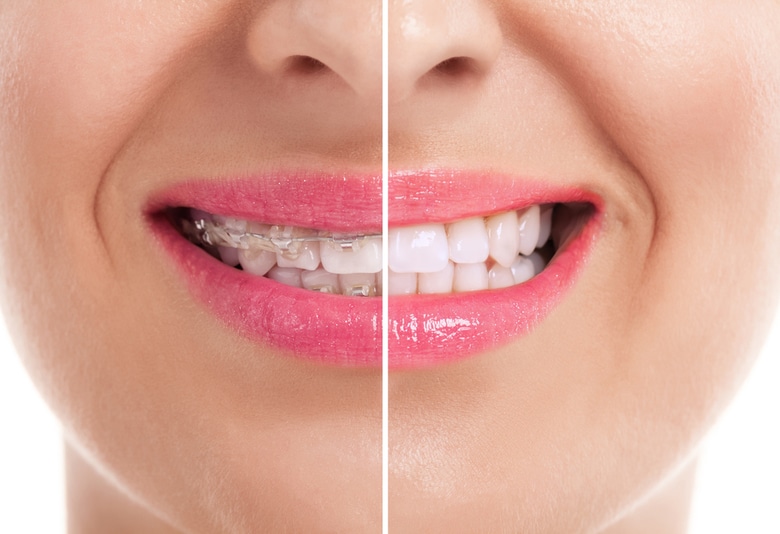How to Get Rid of White Patches on Teeth After Braces? What happens if, after wearing braces, you notice white patches on your teeth? To have straighter, healthier teeth, you had to wear braces for a while.
Knowing what creates ugly yellow stains or white spots on teeth is the first step towards treating them. From there, we can figure out how to keep your smile looking its best and remove “braces stains.”
How to Remove White Spots After Braces.
Occasionally, individuals inquire about how to get rid of white spots left behind after braces. You could have observed white areas on your teeth that are significantly lighter than the surrounding tooth after your braces were taken off.
You could find that those white areas feel a little different as well if you touch them. The region may appear to be somewhat elevated or indented. These lesions are called white spots.
We are aware that finding white spots after having your braces taken off can be upsetting and annoying. You couldn’t wait to show off the outcome of your investment and show off your freshly corrected and straightened teeth. The good news is that a knowledgeable cosmetic dentist can remove those white spots using certain procedures.
It helps to have a better understanding of what white spots are and how they originated before we go into our particular method for removing them from teeth.
What Causes White Spots on Your Teeth When Wearing Braces?
- One of the most frequent consequences of plaque accumulation during orthodontic treatment is the development of white patches on teeth. Plaque may harm your enamel’s outer layers because it includes acidic bacterial byproducts, which are also the cause of tooth decay. The tooth progressively weakens and loses its integrity if you don’t remove it completely each day with brushing and flossing. In some particular places, this procedure may result in a chalky-white look.
- It is more difficult to completely clean teeth with brackets and bands, and you probably overlook the areas behind them. Bacteria and plaque accumulate when you consume sugar- and starch-containing meals and beverages in hard-to-reach areas with your toothbrush.
Behind the tooth enamel, the bacteria cause demineralization, or the loss of minerals in your tooth. Because the enamel is translucent, it looks like there is a white spot there.
Ways to Get Rid of White Spots After Braces
Generally speaking, you are unable to eliminate these white spots on your own. Seeking the services of a qualified cosmetic dentist who offers teeth-whitening procedures is usually the only method to get rid of unsightly stains.
Naturally, this varies according to where the white spots are and how severe they are. To guarantee that the procedure to remove white spots after braces is safe for your teeth, your cosmetic dentist will need to check them.
At Sculpt Dental Spa, we lift and remove stains and white spots that linger after braces are taken off using a minimally invasive mix of polishing and etching procedures. Without any downtime, we complete this in a single appointment! This works the best, in our opinion, to get rid of the white spots.
To help you attain a more evenly brilliant smile, we frequently combine teeth whitening with the removal of white spot stains. You probably want to show off your straight teeth now that you’ve had your braces taken off. Consider it a makeover for your teeth!
Options for Treating White Patches on Teeth After Braces
Treatments for remineralization strengthen teeth and, in the case of milder stains, may also help them vanish. To restore some of the strength and health of your teeth, it’s possible that your orthodontist ordered or advised remineralization therapy.
This is a good alternative to a cosmetic dentist’s whitening and polishing procedure, even if it probably won’t be as successful. Some patients who are eager to show off their new smile may choose remineralization and cosmetic polishing procedures.
Depending on the severity of the lesions, your cosmetic dentist may also use other techniques as part of the therapy.
A cosmetic dentist may occasionally employ dental microabrasion procedures to balance out the roughness and expose smoother enamel when the markings are visibly elevated. The dentist may fill up the deeply depressed areas using a dental resin that matches the colour of the tooth.
If the stains are really severe and noticeable and do not go away with remineralization or whitening procedures, dental veneers may be a viable option in some situations. The thin veneers hide or cover the white spots while also making the teeth appear brilliant and uniformly white. If you decide to go with veneers, a cosmetic dentist can assist.
How to Prevent White Spots if You Currently Wear Braces
You might be able to stop new white spots from developing on your teeth if you now wear braces. The best course of action, though, if you already have white spots, is to see a cosmetic dentist.
Advice for Those Wearing Braces:
- Since bacteria and the acid in sweets are what cause the lesions, limit starchy and sugary meals and drinks. If you do eat them, save them for right before you rinse your teeth after a meal. Among the healthful foods in this are citrus fruits and tomatoes.
- After every meal, wipe your teeth carefully, following the advice of your dentist and orthodontist.
- Drink unflavored, plain water throughout the day to let your mouth’s acids get diluted. If you’ve just had coffee or fruit, think about washing it off or swishing it around.
- For at least two minutes, clean your teeth with a toothbrush with soft bristles. Use caution while brushing, since too-forceful strokes can sometimes damage enamel.
- To assist in remineralizing your teeth, use fluoride-containing toothpaste.
- To get rid of germs under the gum line and in between teeth, floss every day. See your dentist, orthodontist, or hygienist for advice on technique, since wearing braces presents an additional obstacle.
- To irrigate the minuscule areas of your mouth that your toothbrush and dental floss are unable to readily reach, think about utilizing a water flosser and maybe mouthwash.
- During your orthodontic treatment, certain dentists and orthodontists may apply a sealant to your teeth to help keep them safe.
If you already have braces on or, in spite of your best efforts, find white patches, there’s no need to be ashamed. Reaching the areas covered by brackets is really challenging, particularly if you have worn braces since you were a small child.
Summary
Examining the article’s main ideas again highlights how crucial preventive dental care is to the management of White Patches on Teeth After Braces
Giving people the tools they need to take care of their dental health cultivates accountability. A long-lasting, self-assured grin is ensured by proactive behaviours.
It takes perseverance, expert advice, and healthy behaviours to get a smile that looks good after braces. Take the voyage with an optimistic and self-assured you.
FAQs pertaining to White Patches on Teeth After Braces
-
Do white patches always exist?
Depending on what caused them and how they were treated, white spots could or might not go away. Getting advice from a dentist is helpful in deciding what to do.
-
Are white spots avoidable with proper dental hygiene?
Yes, white spots are far less common when proper dental hygiene is maintained. The most important preventative actions include routine dental exams, brushing, and flossing.
-
What is the duration of teeth whitening?
The procedure employed determines how long teeth whitening takes. Results from professional methods could be seen more quickly than with home cures.
-
Do at-home treatments work well for curing white spots?
Although there may be relief with certain home treatments, their effectiveness varies. For a thorough and secure approach, professional counsel is advised.
-
When should I get white patch treatment from a professional?
A visit to the dentist should be prompted by any discernible change in the tooth’s colour or texture. Treatment is more successful when it is initiated early.



